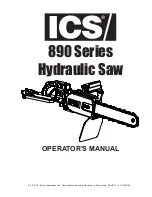
OPERATION
WARNING:
To prevent serious injury, make sure all the warnings and instructions have been read and
understood before operating this tool.
MAKING AN L-CUT (Fig. 16)
L-cuts are used to remove a piece of tile to so that it can fit in a
corner or around a cabinet.
1. Using a marker or grease pencil, mark the line of cut on the tile.
2. Position the rip guide at the desired cutting width from the cut-
ting wheel and securely lock the lever.
3. Place the tile on the table and seat it firmly against the rip guide.
Make sure the material is clear of the cutting wheel before turning
on the saw.
4. Turn the power switch to the ON position. Let the cutting wheel
build up to full speed and wait for the wheel to get wet feeding the
13
TO MAKE A MITER CUT
Miter cuts are used for cutting outside and inside corners on material, decorative chair rail, and base
molding with the material at any angle to the wheel other than 90°. Miter cuts tend to “creep” during cutting.
This can be controlled by holding the workpiece securely against the miter guide.
1.
Using a marker or grease pencil, mark the area to be
cut on material.
2.
Install the miter guide.
3.
Position the rip guide the desired distance from the
wheel for the cut and securely lock the lever.
4.
Set the miter guide to desired angle using the miter
guide scale, and tighten securely with lock knob.
5.
Place the material on the table and firmly against the
rip guide.
6.
Make sure the material is clear of the cutting wheel
before turning on the saw.
7.
Turn the on/off switch to the
ON
position.
8.
Let the cutting wheel build up to full speed and wait for the wheel to get wet before moving the material
into the wheel.
9.
Hold the material firmly against the miter guide and slide miter guide along rip guide. Feed the material
into the cutting wheel.
10.
When the cut is made, turn the saw
OFF
. Wait for the cutting wheel to come to a complete stop before
removing any part of the material.
TO MAKE AN L-CUT
L-cuts are cuts that remove a piece of tile to fit in a corner, around a cabinet, or a piece of molding and are
made by two separate cuts.
NOTE:
Only overcut on the bottom or underneath
side of the material being cut.
1. Using a marker or grease pencil, mark the area
to be cut on material.
2. Remove the miter guide.
3. Position the rip guide the desired distance from
the wheel for the cut and securely lock the
lever.
4. Place the material on the table and firmly
against the rip guide.
5. Make sure the material is clear of the cutting
wheel before turning on the saw.
6.
Turn the on/off switch to the ON position.
7.
Let the cutting wheel build up to full speed and wait for the wheel to get wet before moving the material
into the wheel.
material into the cutting wheel.
5. Hold the material firmly against the rip guide and feed the material into the cutting wheel in a smooth motion.
Make the cut far enough into the material without over-cutting (Fig. 16).
6. Slide the material back and away from the cutting wheel. Adjust the material, adjust the rip guide, and make the
second cut. This time, over-cut the line and the workpiece should separate from the rest of the material.
7. When the cut is finished, turn the saw OFF. Wait for the cutting wheel to come to a complete stop before
removing any part of the tile.
Fig. 16
17
Summary of Contents for 71707
Page 22: ...EXPLODED VIEW PARTS LIST 22 ...
Page 24: ...THANKS FOR REMEMBERING ...








































